In Hollow Knight, looks can be deceiving. A sad little lamplit town may hide the entrance to a beautiful buried kingdom. A towering knight might turn out to be a sad, small thing in oversized armour. An onrushing green beast may actually be a wee creature disguised by a pile of leaves. And a simple-looking 2D action game can slowly unfurl into one of gaming’s great adventures.
Hollow Knight came out on PC in February of 2017. The side-scrolling action platformer was successful and critically celebrated, though it flew under the radar of some websites (ahem) during a spring that featured the launch of a new Nintendo console and an overwhelming bounty of fantastic games.
Some people, myself included, decided to hold off on Hollow Knight until it launched on the handheld Nintendo Switch this year. That day finally came a few weeks back, and I’ve been playing it obsessively ever since.
[referenced url=”https://www.kotaku.com.au/2018/07/hollow-knight-has-sold-more-than-1-million-copies-on-pc/” thumb=”https://www.kotaku.com.au/wp-content/uploads/sites/3/2018/07/hollow-knight-hidden-dreams-410×231.jpg” title=”Hollow Knight Has Sold More Than 1 Million Copies On PC” excerpt=”While there’s been recent talk about how well the Adelaide-made Hollow Knight has done since launching smack-bang in the middle of E3, the game’s inaugural release has also hit a massive milestone.”]
The adventure begins with you in control of the mysterious Knight, a masked, genderless warrior who arrives at the desolate town of Dirtmouth on a quest to explore the ruins below. From there you descend into Hallownest, an ancient, buried kingdom that can only be accessed through the Dirtmouth town well. It soon becomes evident that Hallownest is not operating at human scale.
It is in fact a tiny kingdom of insects, and even in desolation remains sparsely populated by six- and eight-legged talking arthropods. On your travels, you’ll meet a firefly shopkeep, a mystic moth, a joyful charm-selling mollusk, and a rhino beetle blacksmith, among many others.
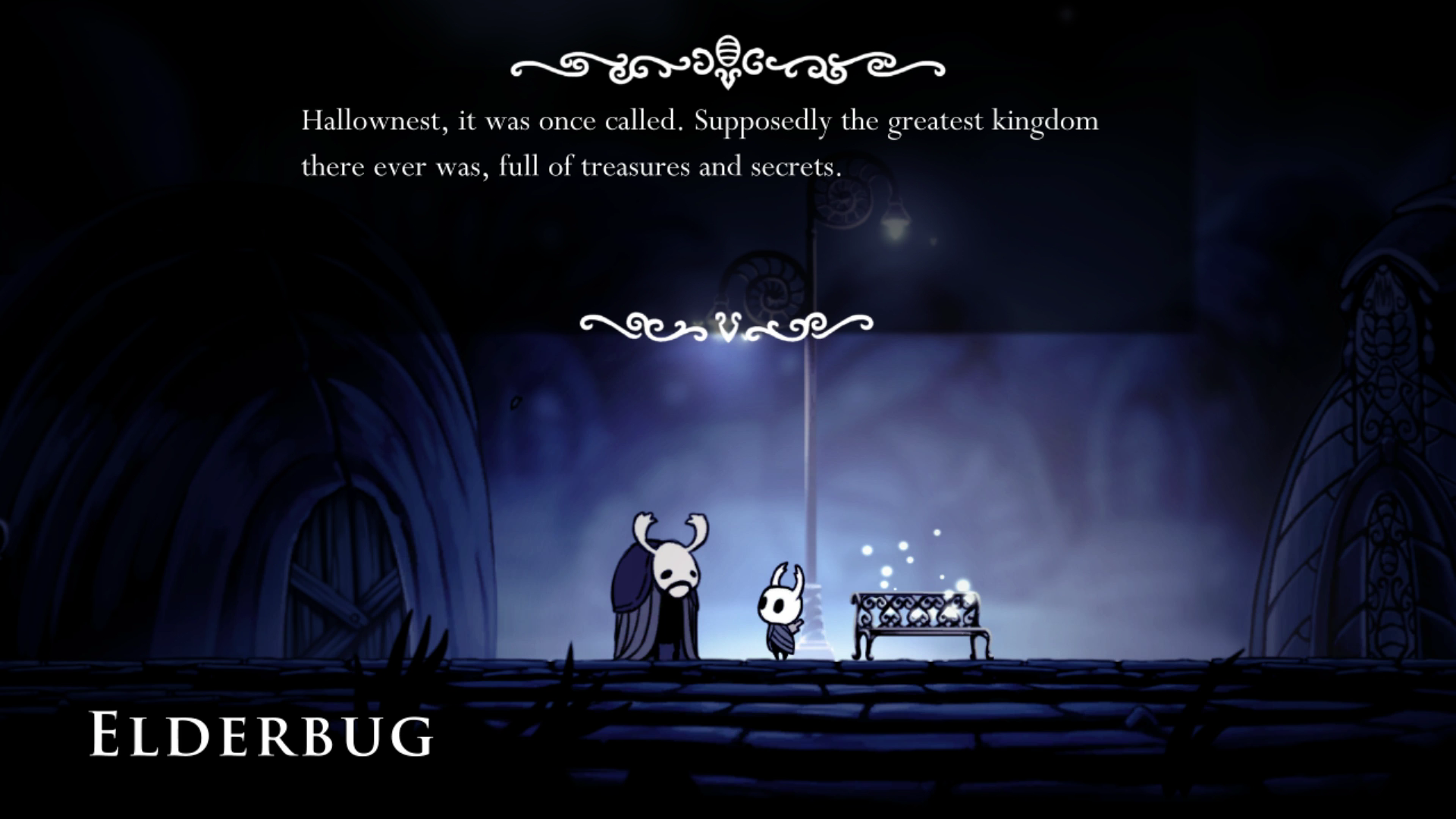
Hollow Knight is another in a long line of “Metroidvania” games, a popular side-scrolling subgenre that combines elements of classic games like Super Metroid and Castlevania: Symphony of the Night.
There’s a large map that you can explore freely, tackling challenges in whatever order you see fit. There are some areas you won’t be able to reach until you get certain upgrades — maybe a wall-jump, or an air-dash, or maybe something more exotic. The more you play, the more powerful and nimble the Knight becomes, and the more of the map becomes available to you. The joy of these types of games comes from gradually discovering new areas of the map and mastering their many challenges, and Hollow Knight has joy aplenty.
In fact, this is one of the easiest reviews I’ll ever write. Hollow Knight is excellent. I’ve been under its thrall for almost 60 hours, the last ten of which I spent wishing I could re-experience it from the beginning. I am astonished that it was made by such a small team — it was primarily developed by two people, though the credits have a handful of additional names in support roles.
I am similarly impressed that a game that modestly raised less than $US50,000 ($67,771) on Kickstarter turned out this well, given how many far better funded projects fizzle. Hollow Knight is one of the most rewarding games I’ve played in a long time. I enthusiastically recommend it.
Most of my warm feelings toward Hollow Knight developed over time. It did not immediately grab my attention, and its opening hours are its weakest. The initial area, the Forgotten Crossroads, is dull.
The Knight responds promptly to button presses and satisfyingly flits through the air with the aid of a generous amount of aftertouch, but their initial move set is limited: players can only jump and slash their “nail,” which is what stands in for a sword in this world of bugs.
The first enemies you face aren’t that interesting, and the first couple of bosses are challenging without offering very exciting rewards. It’s not bad or anything, but it’s a noticeable contrast with how rich the game becomes after a dozen hours, as you’re regularly unlocking interesting abilities, unearthing fascinating secrets, fighting new combinations of the 153 (!!) different creatures in its bestiary, and experimenting with powerful charm upgrades.
However, those slow opening hours are key to understanding what is so good about Hollow Knight. This game establishes what it is in those hours, and while it expands and elaborates on those ideas over time, it never really deviates from that core identity. Hollow Knight is about thoughtful refinement of a basic set of ideas, rather than bold experiments and unpredictable changes in course.
When you first set out into the Forgotten Crossroads, you’ll have to climb to new areas without hitting spikes. You’ll try to swing your sword at enemies without letting them hit you. You’ll defeat bosses to open up new areas and upgrades.
You’ll talk to non-player characters to uncover the kingdom’s backstory. You’ll slowly earn currency from enemies you defeat, saving up to buy upgrades for the Knight. Forty hours into the game, you’ll still be doing all of those things — but thanks to the way the game’s developers have embellished and elaborated on their central concepts, each pursuit will have become much more interesting than it first appeared to be.
Hollow Knight‘s map is a marvel, full of hidden secrets, shortcuts, and some diabolical jumping challenges. Each of its 16-ish regions is connected in a variety of interesting and often logical ways, with metro tramways and elevators linking some of the ancient kingdom’s districts, and with others joined only by broken corridors and aqueduct tunnels. At any moment you might break through a crumbling wall and find a cavernous new area to explore.

You can also quickly travel from region to region by using the “Stagways,” a previously thriving, now defunct series of tunnels travelled by Hallownest’s giant Stag transport beetles. The sole surviving Stag is happy to cart you around on your adventure, offering wistful commentary on the region surrounding each new Stag terminal you unlock. Hollow Knight could easily have tied its fast-travel to a series of magical signposts or some other inanimate object.
The decision by Team Cherry (which is based in Adelaide, South Australia) to instead feature a surprisingly soulful talking transport, complete with its own quest line and backstory, encapsulates much of what makes the game special.
The initially small cast of characters eventually swells, and by the time the credits rolled I found myself unexpectedly charmed by cast members like Cornifer, Bretta, Sly, Salubra, Quirrel, and even the creepy termite Leg Eater.
I also found myself wrapped up in the story of Hallownest, which unfurls gradually over the course of the game. While it contains many of the fallen kingdom/mysterious chosen one tropes I’ve come to expect after years playing Souls games, it gives them enough distinct flavour that I became unexpectedly invested by the end.
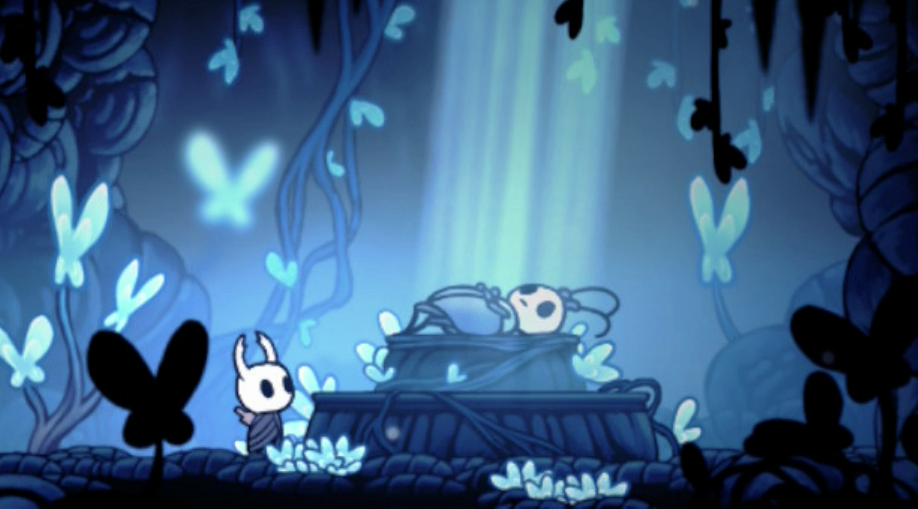
There is little new in Hollow Knight‘s fast-paced and unforgiving combat. The game once again shines again in refinements and small, smart ideas ornamenting its jumpy, slashy core. Jumping and air-dashing feel intuitive and snappy, and after so many hours spent overcoming so many of the game’s most unforgiving challenges, I find myself able to intuitively leap through oncoming volleys of enemy fireballs with a fluidity I never thought I’d be capable of.
Attacking with the Knight’s nail is snappy and immediate. Landing a blow has a physical effect, pushing both enemies and the Knight back from the point of contact. That means landing multiple hits against an enemy requires you to constantly make tiny readjustments to your footing, most of which are micro-calculations that you probably won’t even realise you’re making. Jump from a platform and attack downward onto an enemy to bounce back up into the air.
Slice a second enemy in the air to your right, and you’ll push slightly back to the left. Take a hit from a third enemy, and a low-pass filter crunches over your headphones as the game world momentarily fades to black. The first time it happened, I thought the Knight had died.
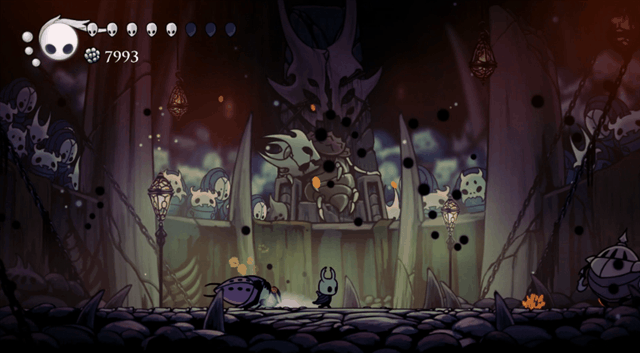
Hollow Knight‘s simple-yet-complex healing system encapsulates the way the game takes basic video game concepts — in this case, you can choose to spend mana points to heal — and refines and expands upon them.
The Knight’s magic energy is called “Soul,” and accumulates in a glass container next to their health bar. Each time you land a hit on an enemy, you get a bit of Soul. You can use Soul to cast one of a small handful of offensive spells you’ll unlock over the course of the game, but you can also use it to perform a move called “Focus,” where you channel some Soul in order to heal a hitpoint.
Focusing your Soul to heal requires you to stand still for a few seconds, and if you cancel the Focus move at any point, you lose the Soul you spent without getting anything in return.
At any moment in the game, you could be faced with several decisions: do you use your focus on a ranged attack, or save it to heal? Is healing worth the risk? Is it better to avoid the boss and try to recover health, or attack and build up your Soul so that you can heal more hit points later on?
Can you be smart enough to choose the right time to heal? Several equippable charms you discover add further dimensions to the focus/health regeneration system, allowing for a even more possible play styles. What begins as a simple healing mechanism is soon refined into something distinct, interesting, and malleable.
Each of Hollow Knight‘s interlocking systems presents the player with a set of risk-reward propositions, and the key to success is being able to smartly make those calculations on the fly. Usually, caution is the wiser option, but there are times when bravely charging forth is the only way to survive. The game’s many challenging boss fights push things even further, and the complex charms system opens the door to all kinds of experimental strategies.
You could equip charms focused on evasion and fast damage, quickly whittling down the boss’s HP while (hopefully) avoiding damage. Or maybe equip charms for a defensive build, eating more attacks but healing more quickly? There’s a charm that deals area-of-attack damage to your foes every time you take a hit, a charm that gives you a bunch more health but prevents you from healing, and a charm that boosts spell damage.
A nimble, fast-attacking boss may counter charms focused on recovery, while a slower-moving boss might demand faster, more powerful attacks.
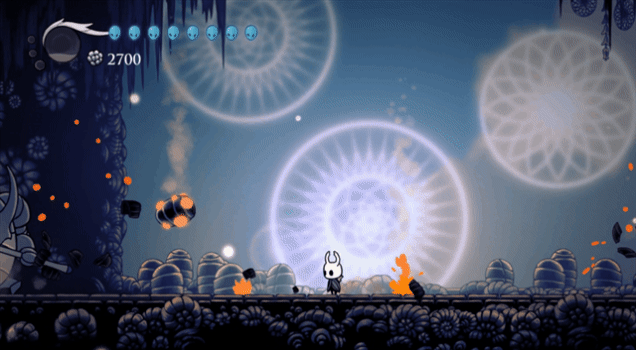
Each of Hollow Knight‘s many bosses is a test, whether of dexterity, cleverness, or aggression. Never is this more the case than with the “true” final boss of the game, an über-hardcore challenge that only becomes available after you complete a long chain of arcane optional objectives.
That fight was without question one of the hardest things I’ve ever attempted in a video game, a pure final exam of pattern memorisation, quick dodging, situational awareness, mental endurance, and straight-up reflexes. While few of the game’s other bosses rise to quite that level of challenge, I still found myself enjoyably frustrated by a few of them, and always on the hunt for more charms to unlock more strategies.
All that jumping and slicing is wrapped up in a lovely aesthetic package. Each hand-drawn character tells a story without saying a word, from Bretta the beetle’s nervous hunch to the sad and stoic Grey Mourner, alone at the outskirts of the kingdom.
Check your map, and the Knight pulls a map from their pocket, reading along with you. The lamps in the City of Tears draw light from fireflies contained within; break a lamp, and the fireflies go free. Composer Christopher Larkin’s elegiac musical score ably defines the game’s mournful tone, while mixing seamlessly with his wonderfully daffy sound design.
A horrifying nest of chittering spiders will give way to a yawning crystal cavern or a peaceful, reverberant lake, and each region’s background music adds layers of instrumentation as you draw nearer to its heart. You may hear a woman performing an aria on the soundtrack, then later meet a spectral butterfly who performs the same piece.
Despite its ambitious scale, Hollow Knight is unified by an unusual degree of artistic focus. Perhaps because it is by and large the work of just a few people — Team Cherry’s Ari Gibson and William Pellen, along with Larkin on sound and a few others in technical roles — almost nothing feels out of place or tacked on. Each character, region, and room exists for a reason that relates to all the other characters, regions, and rooms.
As I explored the City of Tears, a fellow traveller explained to me that he’d heard the city’s constant rain is actually water trickling down from a lake somewhere far above. Later, I found that lake, and I remembered his words, marveling once again at how easy it was to believe in this made-up insect world.
Team Cherry has kept working on Hollow Knight since it launched last February, putting out patches and free DLC that add new dialogue, characters, enemy behaviour, bosses, abilities, and story missions, all of which greatly expand the world of Hallownest.
Several of the bosses I defeated on Switch weren’t in the game at launch, and only in one case — a beehive area where the trek from the save-spot to the boss room was overly long and treacherous — was the addition at all inelegant. I’ve since polished off almost everything in the main game aside from a couple of collectable charms and a handful of optional rematches against juiced-up versions of the main game’s bosses.
Team Cherry is working on more free DLC for later this year, which will add even more new bosses, enemies, areas, characters, and even a new game mode. I can’t wait.
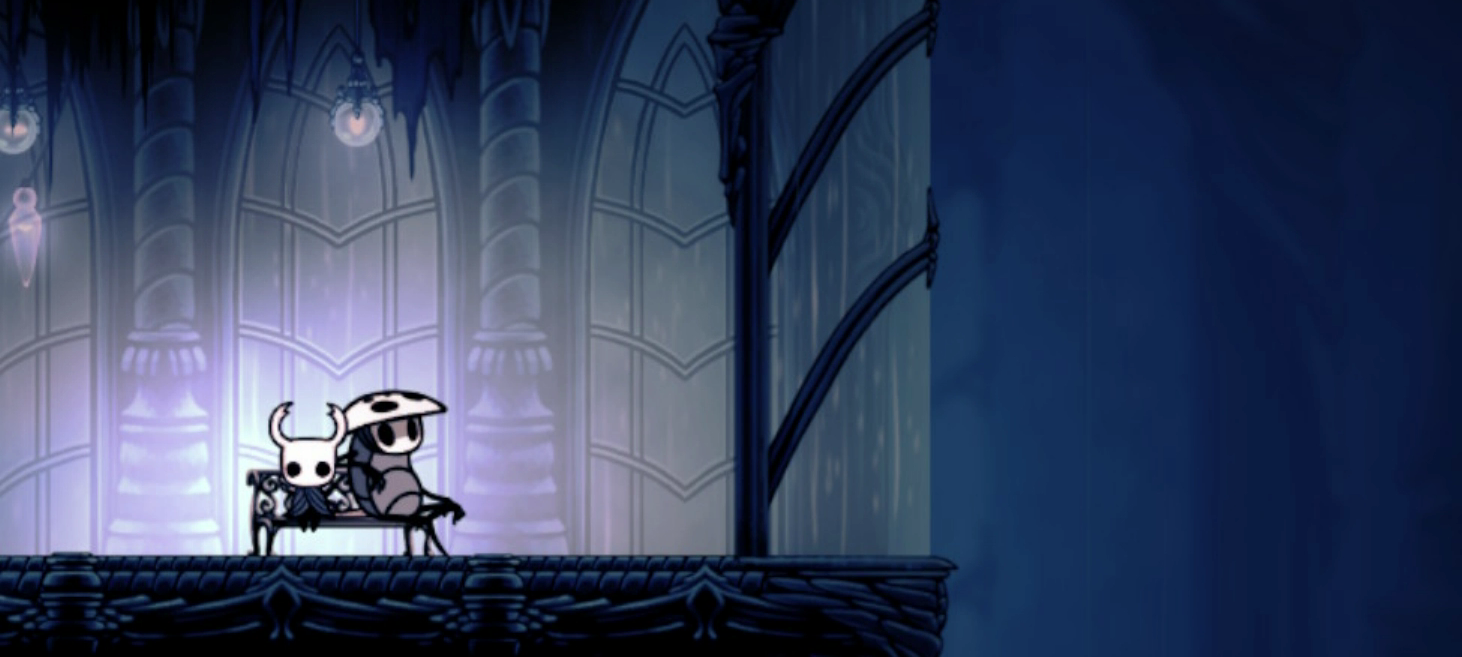
The world of video games has a pronounced bias toward the new. Every year it seems like dozens of games push things forward both technologically and creatively. Hollow Knight is not one of those games, and in fact consistently avoids chasing innovation for its own sake.
It does not reinvent; it refines. It does not rebuild; it polishes. It contains few ideas that I haven’t seen in other games, yet it feels fresh all the same due to how much care has been put into every character, every battle, every frame of animation, and every square inch of its massively minuscule subterranean civilisation.
To hulking humans like us, the kingdom of Hallownest would appear an insignificant mound of dirt. We might step over a dozen such kingdoms on our way to the office, perhaps noticing one just long enough to kick it over or stamp on a few of its residents.
Hollow Knight is a reminder that things are not always as they first appear, and that great rewards await those unafraid to plunge below the surface. Look deeper, it says. There’s magic beneath the soil, if only you’re willing to dig.
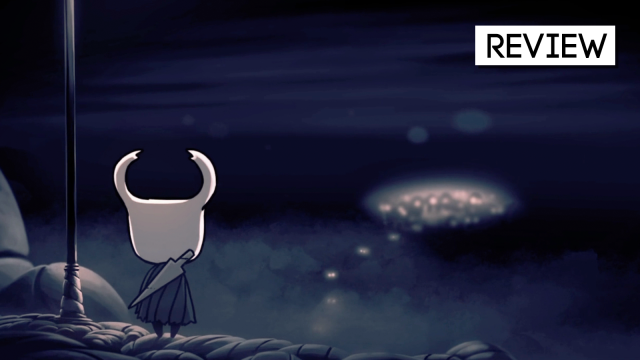
Comments
5 responses to “Hollow Knight: The Kotaku Review”
An amazing game and even it’s not your cup of tea, I highly recommend supporting this local studio and picking it up at some point.
Yay! More Hollow Knight articles pls, Hollowtaku!
But seriously… more pls… o.o
Great game. Easily my most played Switch title.
Ok so I picked this up finally after all the hype I’d read. It isn’t my type of game normally so I was a little skeptical.
Long story short, great game. Has magic and wonder in it. I love plotting out my map in a way I never thought I would.
Can’t stop, won’t stop.
Finally got paid so I was able to pick it up. I’m in a big Metroidvania mood so this scratches the itch perfectly